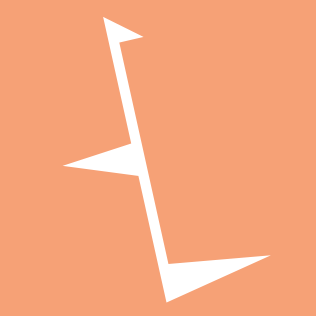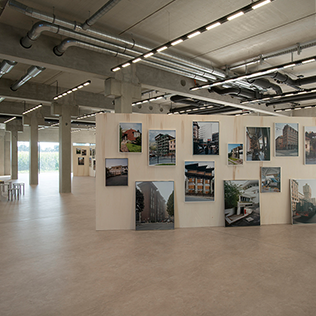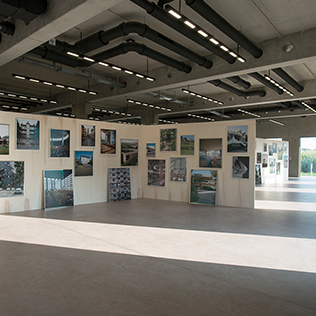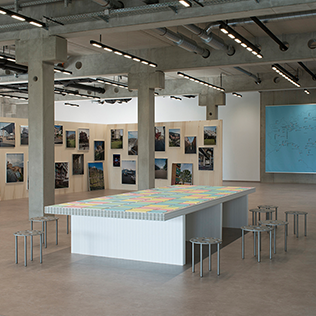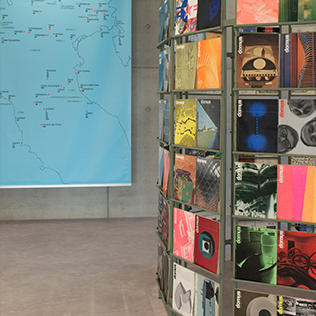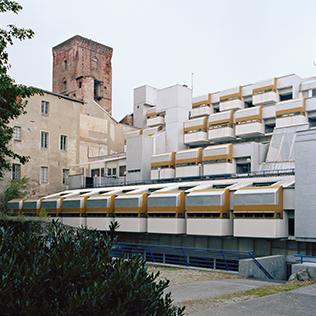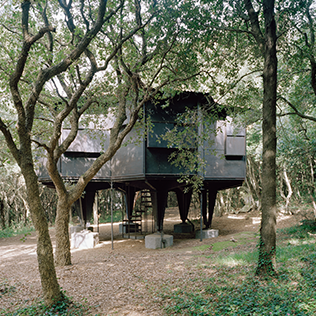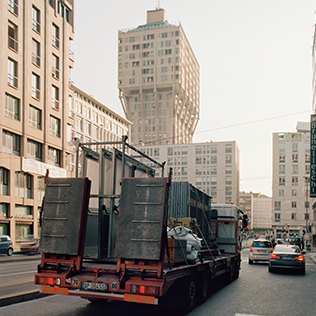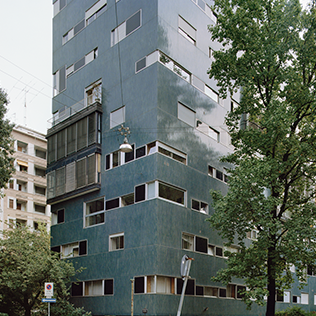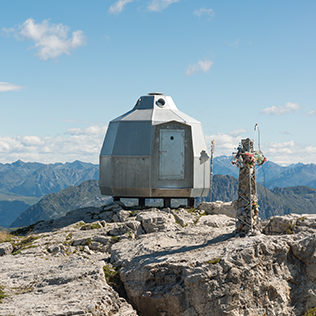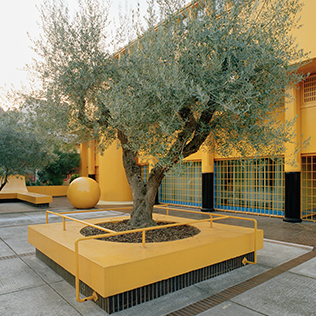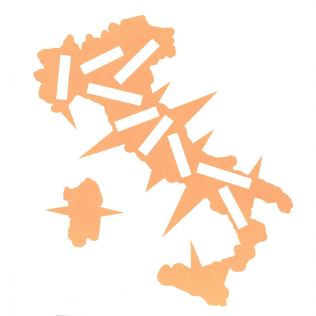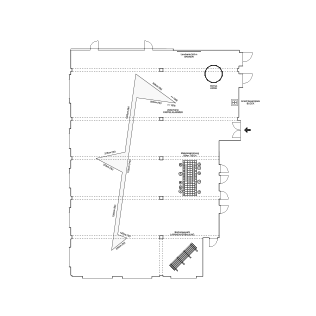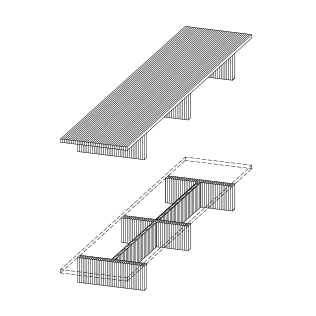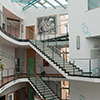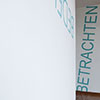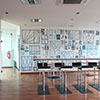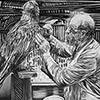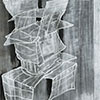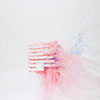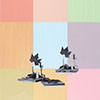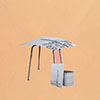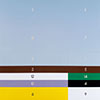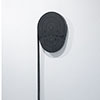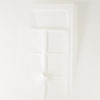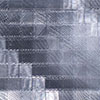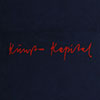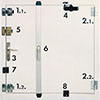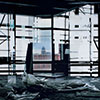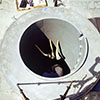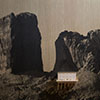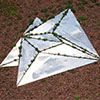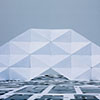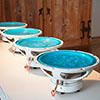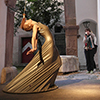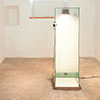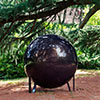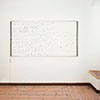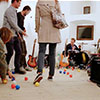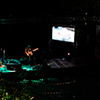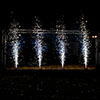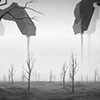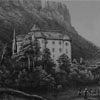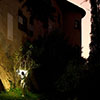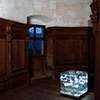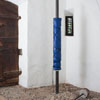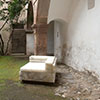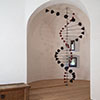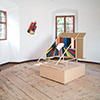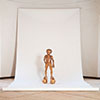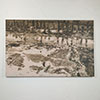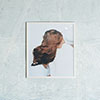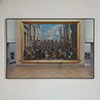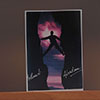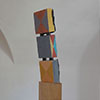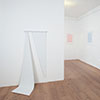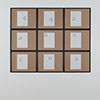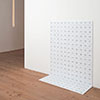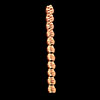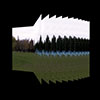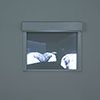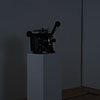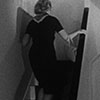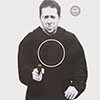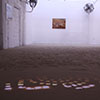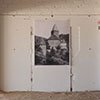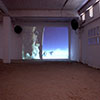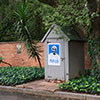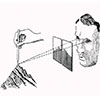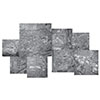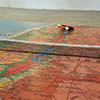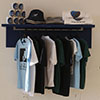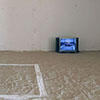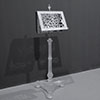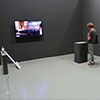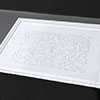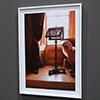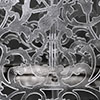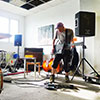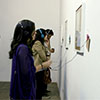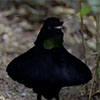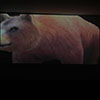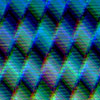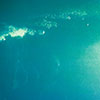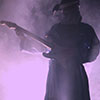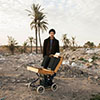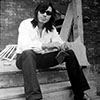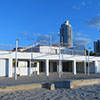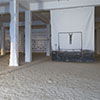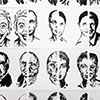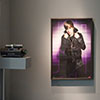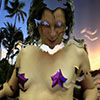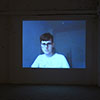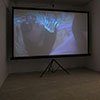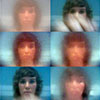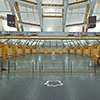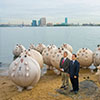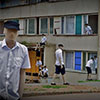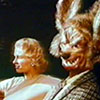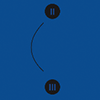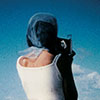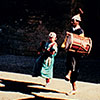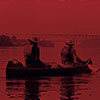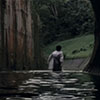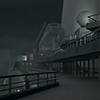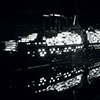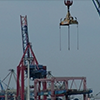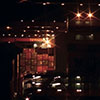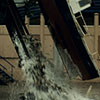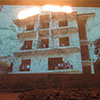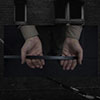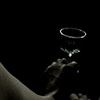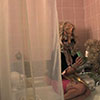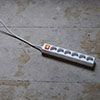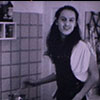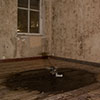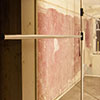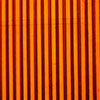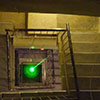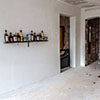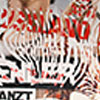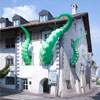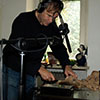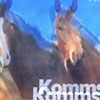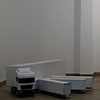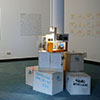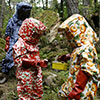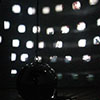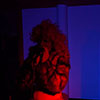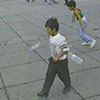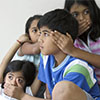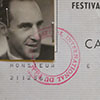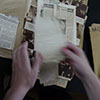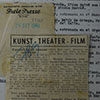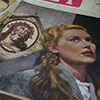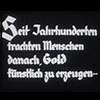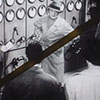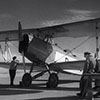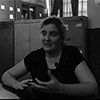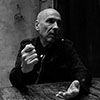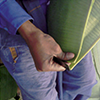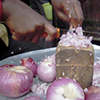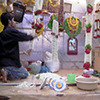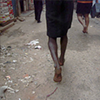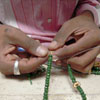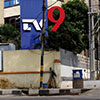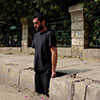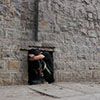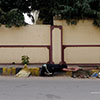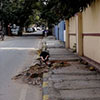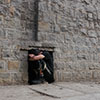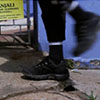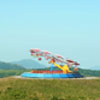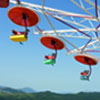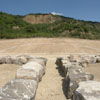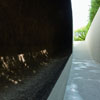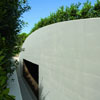With the comprehensive inventory of ITALOMODERN, Martin and Werner Feiersinger draw attention to the heterogeneous architecture of the post-war period in Northern Italy. The focus of the brothers reflects their respective professional approaches, as a sculptor and as an architect. On the one hand it is about the sculptural qualities of the buildings, their materiality and the different surfaces, on the other hand it is about space formation, functional conception and the integration into the environment. Martin and Werner Feiersinger
The spectrum ranges from the precursors of today's tiny houses such as Mario Cavallé Case Zucca in Milan, to small residential buildings such as Gino Valles Casa Rossa in Udine, to residential complexes in Trieste and Genoa that still seem bold today. Among the 115 photographs on display are pictures of the machine-like architecture of the Olivetti Hotel La Serra in Ivrea, the spectacular silhouette of BBPR's Torre Velasca in Milan, and courageous constructions by hardly known architects. Not timeless architecture, then, but buildings that are a clear expression of a time full of optimism and belief in the architectural design of the future.
For the first time in Germany: at Finstral Studio Friedberg. ITALOMODERN results from years of initially private research carried by Martin and Werner Feiersinger. Their photographs, taken on journeys without any purpose of exploitation, were presented to the public for the first time in 2011 in aut. architektur und tirol. The recognition and international response to the exhibition and the catalogue encouraged them to continue their research and travel activities, resulting in ITALOMODERN 2, shown in aut in 2015. After stops in Austria, Switzerland and Italy, the South Tyrolean window manufacturer Finstral is now bringing the exhibition to Germany for the first time.
Expressly for the gallery rooms of Finstral Studio Friedberg, Martin and Werner Feiersinger have designed a arge space object, which at the same time serves as a presentation surface and whose pointed forms are reminiscent of Mendini's drawing Non c'è Italia senza spine: there is no Italy without thorns.
Curated by Arno Ritter (head of aut. architektur und tirol)
Produced by Kathrin & Sarah Oberrauch
The gaze out of the window can be understood as a symbolic gaze in many regards: both as an opening to the world and a glimpse into the soul, as a view of today’s cultural change and social challenges, but also as a drifting, introverted gaze at one’s own needs. As an architectural element, the window marks the interface between private and public and reflects social, cultural as well as medial development.
The exhibition Soft Architecture ranges between architecture, design, and contemporary art. Their hermetically led discourses are deconstructed, providing impulses regarding social and political issues as well as raising aesthetic questions. The exhibition Soft Architecture offers a collaboration of disciplines examining and experimenting with materials while inspecting socioeconomic strategies.
The term soft is used in a variety of contexts: soft material, soft power, soft management, software, or as it were, soft architecture. It immediately evokes connotations of tactility and haptics, pressure and resistance. Qualities like soft, flexible or elastic not only point to a specific materiality, but also represent a particular design vision. Logistic, resources and recycling present new challenges which demand creative solutions. Questions concerning ecological and economic sustainability, working methods and social consequences will be discussed on an artistic level and society’s expectations towards architecture emphasized. For a process of perpetual change of form as well as the continuation of a place through its users and inhabitants, an architecture which is able to respond to social and individual needs against a backdrop of unexpected and drastic changes becomes necessary. Soft Architecture tells the story of architecture which is lived, only to be revealed in its used state. It begins where its planning ends.
Stefan Alber, Hans Op de Beeck, Ulrike Bernard, Céleste Boursier-Mougenot, Loris Cecchini, José Pedro Croft, Igor Eškinja, Stefan Fabi, Werner Feiersinger, Gloria Friedman, Vincent Grunwald, Björn Kämmerer, Veronika Kellndorfer, Michael Kienzer, Pe Lang, Sonia Leimer, Charles Lim, Thomas Locher, Philipp Messner, Lucy & Jorge Orta, David Polzin, Anna Rockwell, Bernardi Roig, Toni Schmale, Michele Spanghero, Petra Steinerova, The UrbUrb, Martina Wolf
curated by Kathrin & Sarah Oberrauch
Art and economy form a powerful union, full of intersections and contradictions. Introducing art in the daily working environment can create a productive concept within a company philosophy through sensual, representational and abstract means. Art has the ability to create disruptions in our day-to-day lives, opening up new experiences and temporarily suspending what is already known.
The company branch in Gochsheim (Germany) also promoted art from the beginning: before its opening in 1995, the conceptual artist Robert Barry was invited to intervene with a site-specific installation. Seventeen years later his words, drawn on the wall of the atrium, still broach the connection between artistic statement, space and time by questioning the medial, institutional and social conditions of art and economy.
The monochrome wall drawing not only conveys a message of fresh concepts, but also becomes a poetic interplay of light and color, an ambiguous shifting between surface and depth. The visualized thought-processes enable a productive adoption by the viewer, appealing to his or her imagination. Other artworks extend this idea, such as Christian Schwarzwald's installation Vol 2. Metanoia: In a cluster of 470 individual drawings, he weaves a mesh of words, windows, thinker poses and abstract motifs. With this method of image hermeneutics, Schwarzwald reflects on the limits of subjective thinking and calls for conditions for a renewed worldview. Which framings, concepts or patterns enable or disable change?
Robert Barry, Thiago Bortolozzo, Tacita Dean, Christoph Hinterhuber, Christian Hutzinger, Michael Kienzer, Hans Knapp, Thomas Locher, Brigitte Mahlknecht, Christian Schwarzwald, Paul Thuile, Rinus Van de Velde, Emmet Williams, Peter Zimmermann
Curated by Kathrin Oberrauch, Marion Oberhofer and Yiannis Pappas
The museum KunstMeran presented for the first time the large collection of contemporary art compiled by this enterprise located on the Ritten. Some of the works actually have a reference to the core message of the Finstral company, as they deal with the topic of housing on an artistic level and thus add a new language and expressiveness to it. The work La Casa (1982–84) by the sculptor Nanni Valentini, for example, occupies a central position in the collection. Symbolically, it stands for the meaning that Hans Oberrauch has attached to this topic and serves as an overriding interpretation approach to the collection.
The geographical focus of the Finstral collection is on works by South Tyrolean, Italian, and Central European artists in general, but is open to special works from all cultural areas and art movements. The Merano arte exhibition showcases a selection of 40 of the 250 works included in the collection. So far, the works in the Finstral collection have only been known through loans to national or international exhibitions.
Kunst Meran is now seizing the opportunity to explore Hans Oberrauch’s very personal experience of art, his direct and emotional encounter with the contemporary art of the past 40 years as a collector, and to make it accessible to the public. The exhibition itself follows this intuitive and delightful approach to the works and respects their uniqueness and history by associatively lining them up. Chronological and cultural borders tumble and give way to a fascinating open space for encountering the most diverse positions of contemporary art.
Eija-Liisa Ahtila, Lois Anvidalfarei, Robert Barry, Madeleine Berkhemer, Joseph Beuys, Domenico Bianchi, Loris Cecchini, Bruno Ceccobelli, José Pedro Croft, Arnold Mario Dall’O, Tacita Dean, Ulrich Egger, Luciano Fabro, Bruno Faidutti, Peter Fellin, Thomas Florschuetz, Douglas Henderson, Birgit Jung-Schmitt, Hans Knapp, Arthur Kostner, Hubert Kostner, Brigitte Kowanz, Michael Kucera, Sol LeWitt, Charles Lim, Thomas Locher, Stefan Löffelhardt, Heinz MacK, Brigitte Mahlknecht, Luc Mattenberger, David Messner, Philipp Messner, Josef Adam Moser, Hannes Norberg, Sarah Oberrauch, Lucy + Jorge Orta, Luca Pancrazzi, Michelangelo Pistoletto, Martin Pohl, Marco Porta, Christian Reisigl, Max Rohr, Stefano Scheda, Mario Schifano, Ivo Rossi Siéf, Esther Stocker, Kenji Takahashi, Paul Thuile, Christian Tinkhauser-Thurner, Marco Tirelli, Giuseppe Uncini, Nanni Valentini, Gerald Van der Kaap, Peer Veneman, Rolf Walz, Emmet Williams, Linda Wolfsgruber, Chen Zhen, Peter Zimmermann
Curated by Valerio Dehò and Kathrin Oberrauch
The exhibition is a sound experiment, revolving around the idea of sound and its performative aspects. Gandegg Castle provides the historical setting for the selected performances and sound installations. The architecture of the castle influences the sound of the artworks and thus plays an important part in the exhibition as a whole. We experience and represent sound in numerous forms, not only as echoing vibrations in the air, but also as the ornamental wave patterns in water and sculptural embodiments of motion. In the presented performances and installations, a number of international as well as regional artists offer conceptions of sound reaching beyond the conventional boundaries of hearing.
While Maren Strack hangs by her hair from the ceiling of the castle, her floor-length latex dress rendering sonic vibrations, the artist Idan Hayosh offers a dazzling lecture performance in the garden that draws the audience closer to the hidden mechanisms of Heavy Metal concerts and warfare. In the middle of the tower stands the spiral-shaped sound installation by American artist Douglas Henderson, bringing to mind the failed Tower of Babel. Michele Spanghero’s black sphere, sheltered by the fur tree in the garden, is both haunting and peaceful, as if ready to explode at any moment. Singaporean artist Song Ming Ang extends our familiar spectrum of sound by recording unexplored noises of old and unused instruments during their technical reconstruction. Sound as a repetitive rhythm of movement is examined in a thought-provoking video installation by Sarah Oberrauch.
Each performance and installation is a unique exploration into the multiple possibilities of sound. In the context of the present exhibition, the audience itself becomes an instrument, a resonant body which participates in the audition.
Song Ming Ang, Baghdassarians & Baltschun, Hans Op de Beeck, Douglas Henderson, Klaas Hübner & Ana Bak, Kaoru Katayama, Ivan Klapez, Pe Lang, Sarah Oberrauch, Yiannis Pappas, Donato Piccolo, Michele Spanghero, Maren Strack
Curated by Kathrin Oberrauch
In collaboration with Transart Festival
The exhibition Hans hat Glück takes place at Gandegg Castle in South Tyrol (Italy), showing part of Hans Oberrauch's private collection. The mediaval castle was mentioned for the first time in 1434, describing its light-coloured tower, while a drawing from the 15th century depicts its characteristic four round towers and its huge surrounding curtain wall. It belonged to the same noble family for five generations and was known as a summer residence as well as a place for meetings and celebrations. For twenty-five years, Castle Gandegg has been the private residence of art collector Hans Oberrauch and his family. The castle wasn't accessible to the broader public for many years – now, it returns to its traditional role and function, once again becoming a place to meet, to exchange thoughts and tell stories.
Hans hat Glück is both the title of the exhibition and a work by Hubert Kostner, which is shown in the first room on the ground floor of the exhibition. It refers loosely to the fairy tale Hans im Glück by the brothers Grimm, a story about a man who works hard for seven years, and is paid his wage - a huge gold nugget, which he loses on his journey back home due to barter trades. Nevertheless, he remains happy as his luggage becomes lighter and lighter, while collecting numerous enriching experiences on the way. For Hans Oberrauch, collecting art is a way of opening himself to the world as well as addressing current affairs and cultural changes. His primary concern is not financial, but rather the broadening of experience and sharing people’s thoughts and ideas. For the first time in his career, he has decided to show his private collection to the public. Approximately 100 artworks are selected, demonstrating the diversity and versatility of contemporary South Tyrolean and international artists, and also representing the important role of collectors in the world of art. Their committed efforts, which often take place in the background, have contributed enormously to the development of a variety of modern and contemporary art works.
Curated by Kathrin Oberrauch, Marion Oberhofer, Margareth Kaserer and Eugenia Lapteva
The Artist in Residence Eau&Gaz is leaving its usual habitat and exploring new venues. For its 5th anniversary, the residence takes place both at its familiar cultural centre of Lanserhaus in Eppan, South-Tyrol, as well as at FuturDome, independent museum, in Milan. Built in 1913, the FuturDome building was home to the last remaining futurists during the 1940s and has remained a place of debate for new aesthetic currents. It's abandoned renovation site, decommissioned prior to the finishing touches, curiously mirrors this sense of anticipation.
During its temporary residence at FuturDome, Eau&Gaz sheds light on its own premises of collective living. By viewing its home location from a distance, Eau&Gaz examines mechanisms of displacement and exclusion. Sigmund Freud once described the uncanny as something which is both familiar and unfamiliar. In its disturbing ambiguity, a slippage between waking and dreaming, it allows different shades of meaning to coexist. The exhibition The Uncanny Valley emphasizes the topographical dimension of the Freudian uncanny by looking into the privacy of the interior for a more general reflection on the question of social and individual estrangement, alienation, exile, and repression.
After the passage to the inner yard of FuturDome, Atelier Van Lieshout’s Mini Capsule Hotel appears in front of you. The interior is not much larger than a double bed, equipped with the very basics: a mattress, sheets, blankets, a night light and an electricity outlet. This tiny blue sleeping box redefines the terms of dwelling, sojourn and rest. Encircled by residential apartments, its functionality becomes accentuated, inviting you to linger comfortably in its inner cell. Shielded from the public, the home generates a refuge, a secure and homely interior. The German word heimlich is first defined as belonging to the house or family and thereby linked to domesticity or being at home. On the other hand, besides its meanings surrounding the familiar and congenial, heimlich also means concealed and kept out of sight. Etymologically, the English word canny carries a similar ambiguity, primarily meaning knowing or wise, but also cozy and endowed with occult or magical powers.
Atelier Van Lieshout, Carlo Benvenuto, Masatoshi Noguchi, Aslı Çavuşoğlu & Ersöz Ata, Yael Frank, Stefan Alber, Silvia Hell, Vincent Grünwald, Mrova, Cornelia Herfurtner & David Iselin-Ricketts & John MacLean, Linda Kuhn, Max Rohr
Texts by Peter Paul Kainrath, Atto Belloli Ardessi, Chiara Ianeselli, Katharina Wendler, Ginevra Bria, Eugenia Lapteva, Sally Haftel Naveh, Camilla Angolini
Curated by Kathrin & Sarah Oberrauch
Photographs by Cosimo Filippini
Eau & gaz à tous les étages is a sign frequently found on the facades of French houses. Originally, it indicated that the building was equipped with running water and gas. First appearing towards the end of the 19th century, it designated new standards of living and modern comfort. The theme of the blue enamel plates with white lettering was used as objet trouvé by Marcel Duchamp. To him, the recurring motive was not just a signifier of modern convenience, but also its precondition.
The objet trouvé could be read as undermining established traditional understandings of artworks as characterised by artistic talent and skill. Today, the concept has a long-standing tradition and has lost many of its subversive traits. Nevertheless, by relating back to the notion of the readymade and reappropriating the meaning of the service slogan of Eau & Gaz, we would like to raise questions about the standards and conventions within contemporary art and their possible breakup or extensions.
The objet trouvé is an object borrowed from the everyday which attains new meanings in the context of art. Similarly, the artist residency could be viewed simultaneously as a commonplace and something exotic in the village. The seclusion and homogeneity of the village stand in stark contrast to the usual urban centres of cultural scenes. The residency shall become a refuge for artists. This retreat, cut off from constant external activities, offers a space of intense confrontation with one's own work.
Artworks by Saori Kuno, Cornelia Herfurtner, John MacLean, Björn Kämmerer, Asaf Elkalei, Shahar Binjamini; Textes by Marion Oberhofer, Margareth Kaserer, Piotr Piskozub, Elisabeth Obermeier; Curated by Sarah and Kathrin Oberrauch
No man is an Island, entire of it self The sentential statement goes back to the british writer John Donne (1572- 1631). Since then the quote was frequently used as a title and became a known plea for solidarity in popular culture. Contemporary philosophy defines the subject as always socially and culturally constituted. Gilles Deleuze and Felix Guattari show that power is not exercised on the individual, but on diversities who populate, colonize and dwell on territories. In A Thousand Plateaus, the philosophers write that the territory is an act, a practice, which affects environments and rhythms that are territorialized. It is not only the space we live in (a house, hospital, church, university or museum), but it is a converging point of semiotic, linguistic, discursive and non-discursive components - a hard-fought space. Territories enable our existence in the first place: at the same time they represent the cage of our submission, but also the point where potential shifts can happen.
With this premises, the exhibition No man is an Island brings together contemporary artists from Israel and Switzerland who are reflecting through their artistic practices on the present time and the history of structures and territories. The artworks take a position, occupy a point of view and approach spatial phenomena on analytical, poetical or subversive ways. The exhibition wanders through various territories and exposes their function as carriers of cultural memory. Cultural memory plays a fundamental role in the formation of national or collective identities and it has its punctual fixed points. The Germain Egyptologist, religious scholar and cultural scientist Jan Assmann defines such punctual fixations as points which represent fateful events of the past whose memories are kept alive through cultural forms (texts, rituals, monuments) and institutionalized communication (recitation, inspection, observation). Thus cultural memory is also topographically organized. In every present time it is appropriated, interpreted, preserved and altered - it is the present-day which updates memories and puts them into perspective.
The works in the exhibition No man is an Island show how certain territorial discourses in Switzerland as well as in Israel are connecting with subjective bodily experiences. They start from main intersections where society and territory exist in relations of tension and open up new perspectives within the sociology of space. During this process, the critical angle is defined as an imagined outside perspective which is aware of its own impossibility. Neither art is an island. Instead, we propose to consider art as a space of tension in which works and practices position themselves. Within this field, it becomes possible to examine always anew how concepts of artistic autonomy and plurality of practices act in relation to critical thought and political agency.
Marina Belobrovaja, Beni Bischof, Sasha Huber, Miro Schawalder, Fatma Shanan Dery, Tamir Zadok, Ariel Reichman, Belu-Simion Fainaru, Roy Brand, Ori Scialom, Keren Yeala-Golan, Eyal Sagui Bizawe
Curated by Marion Oberhofer and Kathrin Oberrauch
Supported by ProHelvetia
Inspired by a chance encounter with a 19thcentury music stand, Something Old, Something New traces Ang’s attempt to replicate the ornately carved music stand as a glass sculpture, combining traditional and modern techniques of glassmaking. In using glass as material, Ang’s sculpture gains fragility, losing its functionality and becoming an aesthetic object in its own right, blurring the distinctions between sculpture, ornament, design and functional object. The translation of materiality causes a shift in perception of the music stand and its usages. Ang’s installation links his interest in labour and traditional craftsmanship to his own conceptual impulses to art making. A variety of media, including a video, drawings and photography illustrate different steps in the sculpture's complex making process.
Song Ming Ang (b. 1980 Singapore) focuses on music as a subject in his art practice. His work is often processoriented, playing with overlapping perspectives of artist, fan, and amateur. For his work Backwards Bach (2013), Ang learnt and performed a Bach prelude backwards as an untrained harpsichordist. In Parts and Labour (2012), he apprenticed at a piano workshop over four months to restore a disused piano. Ang holds an MA in Aural & Visual Cultures from Goldsmiths College (London). He has presented works with Künstlerhaus Bethanien (Berlin), Museum of Contemporary Art (Sydney), Haus der Kulturen der Welt (Berlin), Witte de With (Rotterdam), and Spring Workshop (Hong Kong).
Curated by Carolyn Christov-Bakargiev
Supported by Previous Hospitalfield
Produced by Kathrin Oberrauch & Vetroricerca
The notion of Ritornello (Italian; ‘little return’) was first used to describe the re-inviting passage in classical music: It is a melody which repeats itself and is played by all musicians together. The exhibition Ritornello presents sound works by artists with different cultural backgrounds and unites their plurality on one stage. The heterogeneity of melodies meeting in the art space carries the idea of harmonious merging, but also generates a cacophony, providing the possibility for new and unheard motives to evolve.
This project refers to Deleuze and Guattari’s concept of the Ritornello as developed in Thousand Plateaus. Their understanding of the Ritornello is one of a positive force which operates within a certain territory, interacting with already existing forces to create a new spatial arrangement. Using this metaphor, each individual is pervaded by a multitude of Ritornellos, linking memory and experience of territory. The Ritornello consists of a certain gravity, a materiality which organizes and structures a territory temporarily. This phenomena functions musically, playfully, politically, economically, socially and in connection with desire. In a spiritual sense, it expresses the idea of a homeland. The chant of the artistic voice, like the voice in a song, is elevated from personal position to concrete function, always in relation to a certain territory. My territory, the territory which I no longer own, the territory which I try to reach again, is what composes the song.
Today, the sounds of everyday life can be read as a globalized sound vocabulary, challenging the notion of artistic creation and, with the help of critical reading, inviting moments of disturbance.
Ahmed El Shaer, Douglas Henderson, Michele Spanghero, Sarah Oberrauch, Song Ming Ang, Yara Mekawi, Yasmine El-Meligy, Yiannis Pappas, Tan Pin Pin, Malik Benjelloul, Christopher Kirkley
Curated by Kathrin & Sarah Oberrauch
In history and mythology, concepts of mirrors were considered magical, often associated with the power of insights into past or future realities - mirrors representing thresholds into other worlds. The idea of a dual image or a split being is carried on in the ideas of french psychoanalyst Jaques Lacan, whose famous development of the mirror stage describes the mirror as key in the constitution of subjectivity by offering the imaginary order of a coherent body-image, the Self.
Today we watch ourselves not only in mirrors, but capture those images with digital cameras and smartphones. Self-observation and self-criticism have become preoccupations reserved largely, if not entirely, for the world of social media. We shape and re-shape our Selves by altering our virtual image in the eyes of others: we have become our own avatar in a digital universe.
The exhibition ME, ME, MIRROR revolves around the question of self-(re-)presentation, issues further reflected and extended in the works of 15 selected artists. The Self is revealed as something malleable, subject to alteration from image to image, loosing its static state and absorbed in an endless process of transformation and becoming. The artists aim to connect cultural, religious, political and ideological contexts in new digitally produced images, creating a new kind of utopian human re-presentation.
Song Ming Ang, Adam Curtis, Helena Dietrich, Idan Hayosh & Corina Künzli, Helmut Heiss, Talia Link, Martin Kohout, Yiannis Pappas, Christian Schwarzwald, Yes Men, Ztohoven, Adreas Zingerle, Sarah Oberrauch
Curated by Kathrin Oberrauch
The film screening SHIFTING FRAMES attempts to reflect on differences of visualizing or experiencing space. At the heart of aesthetic and scientific processes of Western culture lies a fundamental desire to eliminate the uncertainty of the unknown - unfamiliar phenomena are rendered intelligible through visual and rational representation.
In this paradigm of a perceiver overviewing, the subject is placed at a distance, allowing an elevated vantage point from which to survey the space as a whole, separating it from the surrounding environment and constructing the world prior to a practical engagement with it. This scopic drive, as Michel de Certeau terms it, is the basic organising principle of modernity and signals a violent attempt to dominate the external world in thought. De Certeau examines the relationships of place as a fixed position and space as a realm of practices, and their corresponding invocations of mapping and acts of traveling as two functionally different registers of experience.
SHIFTING FRAMES invites the audience into a moving space where singular journeys intersect and collide, disintegrating the hegemony of fixed positions. The selected films deconstruct traditional narrative structures and put into question the possibility of a disengaged gaze. Different stories and experiences of time, space and travel are uncovered from multicentric perspectives which challenge the viewer to submit to an experience of disorientation and indeterminacy. The aim of the specific context of the film screening is to encourage this leap – to create a mise en abyme which shatters the clear demarcation between beholder and content and offers the viewers what I hope to be a very special evening of shifting frames.
Marie Reinert, Bouchra Khalili, Simon Starling, Hans Op de Beeck, Charles Lim, Marcellvs L. Monsieur Moo & Luise Drubigny, Lisl Ponger
Curated by Kathrin Oberrauch
Between Torstraße and Zehdenicker Straße lies Berlin’s oldest preserved symbol of public housing policy: the Kleine Bremer Höhe, built in 1850 by the Berliner Gemeinnützige Baugesellschaft. Five of the 80 apartments are currently still inhabited – this is the result of years of intensive letting strategy, of which the remaining residents can tell disturbing stories. Many of these stories and the tenants who tell them will be forgotten as soon as the building complex is luxuriously modernised, and a new chapter in Kleine Bremer Höhe begins.
The exhibition Tutti_Fuori celebrates the ephemeral open space of this paradise in the middle of Berlin. The exhibition lasts only three days. Most of the artists are based in Berlin and are familiar with the endless discussion of eviction and gentrification, which affects them as well as driving them. In these musty walls, however, the song of critiques of capitalism can still be sung unabashedly.
The exhibited works revolve around the problem of the diametrically opposed world of living in the city. The fleeting, ghostly construction sites in Thiago Bortolozzo’s watercolour paintings, for example, solidify into lived reality in the video work dreams come tr by Tekla Aslanishvili, in which she reflects on Albania’s failed housing policy of the 1990s. Works such as those by The Wa humorously allude to trophy hunting and the territorial marking of graffiti. Works by the 24 artists can be seen on more than four floors; the electricity for the entire exhibition stems from a single, still functioning socket in the cellar and runs through the entire building and courtyard via a 250 metre cable. Anyone who wants to clear out here will have an easy job.
Tekla Asianishvili, Andreas Baader, Shahar Binyamini, Thiago Bortolozzo, Markus Bukereit, Paul Darius, Helena Dietrich, Idan Hayosh, Cornelia Herfurtner, Margareth Kaserer, Koben, Matthias Lintner, Johann Lurf, John MacLean, Julian Oberhofer, Kathrin Oberrauch, Sarah Oberrauch, Yiannis Pappas, Piotr Piskozub, Felix Stumpf, Sebastian Siechold, The Wa
Curated by Matthias Lintner, Sarah und Kathrin Oberrauch
To stroll through the unused shopping mall of Eppan (South Tyrol, Italy) is a disconcerting experience, almost adventurous and at the same time absolutely mundane. The historic building from the 17th century that houses the shopping mall has been reconstructed in order to prepare it for its new and as-yet unfulfilled function. The newly renovated shop windows attract our attention and lead us inside, where we encounter nothing but desolate salesrooms. Within this walls we organized the exhibition Commonsense.
Roughly 700 square meters, spread across several floors, are filled with works of contemporary art in order to initiate an investigation into the premises of our living together within one communal space. What is the role of the individual here? What drives us and seduces us in our everyday life? Which processes of cognition and what kind of knowledge prevails in terms of building our opinions and shaping our actions? By raising these questions, art inevitably reveals itself as an ideological as well as individual and collective practice. Due to the unique set-up of the exhibition it was possible to see the art works on display in the shop windows 24 hours a day.
The art space becomes an integrated part of the daily life in the village, while at the same time remaining essentially out of place – a foreign body that offers and even provokes questions regarding everyday life and the social conditions of communal living. Our aim is to intensify the dialogue about the relationship between art and community, by presenting a diverse program of performances, video and film projections, installations and workshops for students.
Together with the invited local and international artists, we intend to transform the building into an art space of the globalized world and finally to focus on our own culture, which suddenly appears strange and incomprehensible enough to re-discover it again from a completely new point of view.
Anna Rockwell, Atelier Van Lieshout, Brigitte Mahlknecht, Clement Laigle, Constantin Luser, Daniel Hafner, Douglas Henderson, Filthy Luker & Pedro, Estrella, Fine Art Union, Francis Alÿs, Hannes Egger, Helmuth Heiss, Hubert Kostner, Igor Eskinja, Isa Melsheimer, Jitka Hanzlova, Johannes Vogl, John MacLean, Josef Rainer, Liquid Cat, Madeleine Berkhemer, Margareth Kaserer & Rodolphe Coster, Mrova, Moataz Nasr, Nicolò Degiorgis, Panamarenko, Ria Patrizia Röder, Sarah Oberrauch, Sheri Avraham, Shilpa Gupta
Curated by Marion Oberhofer & Kathrin Oberrauch
In collaboration with the contemporary art and music Festival Transart
The film and video program Ocular Spectacular shows works from international experimental filmmakers and video artists in a special framing. As an anacrusis to elected musical performances of the contemporary art and music festival Transart (South Tyrol), it aims to challenge the visual habits of the audience and to break the perceptual patterns of everyday life.
The brain becomes the cinema screen. Gaps, blank spaces and explosions - in just a few minutes the films and videos refute theoretical assumptions, shift perspectives in a cubistic manner, blur the borders between abstract and concrete, as well as analogue and digital. Technical possibilities are fathomed out, each time different, once ironically and other times poetically, to make us experience something which is not shown in the image itself. These very particular works allow extremes to clash: both diffuse and enigmatic, they require intense concentration, demanding the audience to be entirely ear and entirely eye.
Martin Arnold, Bjørn Melhus, People Like Us, Johann Lurf, Hans Op de Beeck
Curated by Marion Oberhofer & Kathrin Oberrauch
Produced by Contemporary Art and Music Festival Transart, South Tyrol
The filmic works by Ernst Rechenmacher mark the initial point of our project. Known as Ernesto Remani since 1945, Rechenmacher was born 1906 in Merano and died 1966 in Frankfurt am Main. Today, despite or perhaps because of his controversial biography, the director and producer remains largely forgotten. In the course of his career, Remani worked for different regimes such as the Nazi-Regime, the Peronism in Argentina and the GDR in East Germany. His life was accompanied by a strong interest in the genre of the entertainment film and in particular the melodrama.
In our research, the methodical work with found footage material of Remani's films which reviews social, political and economic circumstances as well as the influences of media and technological developments provides a basis for analysing the films' particular aesthetics as well as the ideological and economical handling of their production and distribution.
Special attention is paid to recurring motifs and lines of narrative that emerge, but also to gaps in the plot which reveal pressures of social context. Interviews with experts complement the analysis of artistic and commercial moments of Remani's work. While trying to close the voids in the filmmaker’s biography, we also seek to expose how fiction and documentation don't mutually exclude each other.
The aim is to highlight the potential of historical representation in television, which was and is unquestionably a dominant image-medium and thus also an evident agent of popular historical display. By focusing on the specific qualities of these images, we hope to communicate a critical and self-reflexive understanding of history, as well as providing alternatives to written discourse and linear forms of narratives.
INTERVIEWS WITH: Ralf Schenk (film publicist), Paula Felix-Didiér (director of the Museo del cine „Pablo Ducrós Hicken“, Uki Goni (historian, publicist - „The Re autonomous al Odessa“), Patricia Civelli (journalist), Maximo Barro (professor for film history on the „Faculdade Armando Alvares Penteado“)
DIRECTOR Marion Oberhofer
DIRECTOR OF IMAGE Kathrin Oberrauch
SUPPORTED BY Autonomous Region of South Tyrol and the Academy of Fine Arts Vienna
Production has almost entirely disappeared from the surface of the Western world, it has become invisible. In India, manufacturing and sales occur at the same place. The market is not only a meeting place for seller and buyers, but also a space for creative work. Working hands and feet occupy even the smallest nooks. The video "Work in progress" documents different artisanal processes in an encyclopedic manner. Artisanal work obtains a museal character through geographical delocalization.
VIDEO BY Yiannis Pappas and Kathrin Oberrauch
SUPPORTED BY Goethe Institute Bangalore, India
Law of the Market Freies Museum Berlin, Germany
Walking is a process of rhythmic alternation, which unfolds in space and time. It is closely connected to the physicality of a subject. This fleeting, ephemeral process bears a performative aesthetic, it emerges and disappears in an instant - step by step. At best it leaves some traces. In the work «MIND THE GAPS» the camera follows a „European“ dressed person through the streets of Bangalore City. The road is marked by gaps and barriers, turning the city landscape itself into an instable and insecure motion. With this motion study Kathrin Oberrauch and Yiannis Pappas want to shed light on the double meaning of belief in economic progress.
PHOTOGRAPHIES BY Yiannis Pappas and Kathrin Oberrauch
SUPPORTED BY Goethe Institute Bangalore, India
Law of the Market Freies Museum Berlin, Germany
In summer 2009, the first edition of ArtePollino took place in the Pollino National Park, the biggest natural park in Italy. An initiative of Sensi Contemporanei, this program is supported by the Ministry of Cultural Heritage and Activities and the Venice Biennale Foundation and aims to promote and improve one of the most beautiful natural areas in Europe, involving artists such as Anish Kapoor, Carsten Höller, Daniel Buren and Giuseppe Penone. The project intends to increase the value of the environmental patrimony of Pollino National park through bio-compatible artistic interventions and to contribute to the ecological cause by introducing a new theme of contemporary art in the park.
ArtePollino's ambitious vision lies in pushing for progressive change in the area of Pollino. What makes the area attractive is not only the static beauty of its landscapes, but also the dynamic abilities of its inhabitants when it comes to use of environmental resources. Over the past decades, art - especially contemporary art - has often focused on the issue of balance between nature, culture, social and environmental development, seeking to strike the difficult balance between beauty and everyday life. Drawing from the powerful and mysterious world of symbols, art is able to point to solutions, express ideas, and offer glimpses of utopic visions. The ArtePollino project hopes to give birth to a new model which sees art as a key element for enhancing local environments.
The selected artists for ArtePollino offer works which, as Vicente Todoli puts it, "are able to interpret the spirit of the place and, at the same time, call the world's attention to this territory". With ArtePollino, the region Basilicata counts on culture and contemporary art as an engine for the territorial development and the establishing of "another south".
INTERVIEWS WITH: Anish Kapoor, Carsten Höller, Daniel Buren, Giuseppe Penone, Vicente Todoli (Tate Modern), Vito de Filippe (president of the region Basilicata), Mario Cristiani (association Arte all'Arte), Catterina Seia (UniCredit Group), Laura Barreca (Ministry of Cultural Heritage), Alberto Versace (Ministry of Economic Development)
DIRECTED BY Kathrin Oberrauch and Marion Oberhofer
PRODUCED BY Association Arte all'Arte, Tuscany (Italy)
About
The curatorial practice of the collective Mimikry productions aims to create the possibilities for aesthetic production and question forms of representation as well as modes of displays. It seeks for spaces – institutional and public, forgotten ones or those who play a crucial role in everyday life – in order to provide communal experiences and challenge perceptions and sensual distribution. Collaboration for us means also to seek for new accomplices and establish loose, but effective networks. Mimikry as a curatorial strategy means inventive abundance, blurring borders and possibilities of subversive resistance.
Mimkry productions was founded in 2006 giving a name to the collaborative projects of:
Kathrin Oberrauch born in 1981 in Bozen (Italy). She has been active in the art scene for several years. After earning her degree in “New Media” at merz Academy in Stuttgart, Germany, she pursued her education further, receiving a second degree in “Spatial Strategies” at the Weißensee Academy of Art in Berlin in 2013. She has worked as an independent curator and producer for various institutions including: HaRiviera (Tel Aviv), Darb1718 (Cairo), Associate Arte all’Arte (San Gimignano), Arte Continua (San Gimignano Le Moulin Beijing), Arte Pollino (Basilicata), Forum Factory (Berlin), ArtBus (New York), Goethe Institute (Bangalore), Kunsthaus (Meran), Transart Festival (South Tyrol) Freies Museum (Berlin). Since 2009 she curates the contemporary art collection Finstral. Additionally, she is cofounder of the artist in residency Eau & Gaz at St. Michael, Italy.
Marion Oberhofer born 1982 in Bozen (Italy). Bachelor of media, art and design theory at the Zürcher Hochschule der Künste (Switzerland) in 2008. Since 2010 studies at the Academy of Fine Arts Vienna (Harun Farocki). Currently working on the thesis. Realization of various exhibition- and film-projects with different accomplices. Working experiences as teacher, art-mediator (Manifesta7 and Generali Foundation) and journalist.
